Nhf, Norsk Heraldisk Forening

Gules, two Axes Argent, hafted Or, addorsed, issuant from the base; overall, at the nombril, an Escutcheon Or.
Escudo de gules, dos hachas adosadas de plata, fustadas de oro, movientes de la punta; brochante sobre el todo, en el ombligo, un escudete de oro.
Coat of arms interpreted with: the semicircular shape; its field illuminated with Gules; its figures and escutcheon illuminated with Or and Argent and outlined in Sable; and with a free hand texture.
At the nombril
A distinctive feature of this coat of arms is that its escutcheon, instead of being overall in the center, is positioned on a point of the coat of arms called the nombril, which, as we learn from [Avilés, J.; 1725a; page 159 and illustration 19] and also [Avilés, J.; 1780a; pages 147 and 148], in «Heraldry, the nombril of the coat of arms, is the place through which the human body receives nourishment in the mother's womb, and in the shield, it corresponds to the point where the fess ends and the base begins.».
If this escutcheon, «escudete» in Castilian, had been positioned in the center of the coat of arms, then it would have to be blazoned as the piece called an inescutcheon, «escusón» in Castilian. In fact, the Norsk Heraldisk Forening uses the English term «escutcheon» to describe the blazon of its arms.
Blazon keywords: Without divisions, Gules, Axe, Argent, Hafted, Or, Addorsed, Issuant from base, Overall, At the nombril and Escutcheon.
Style keywords: Semi-circular, Illuminated, Outlined in sable, Shaded and Soft metal.
Classification: Interpreted, Socioeconomic and Coat of arms.
Bearer: Norsk Heraldisk Forening.


This site does not use cookies
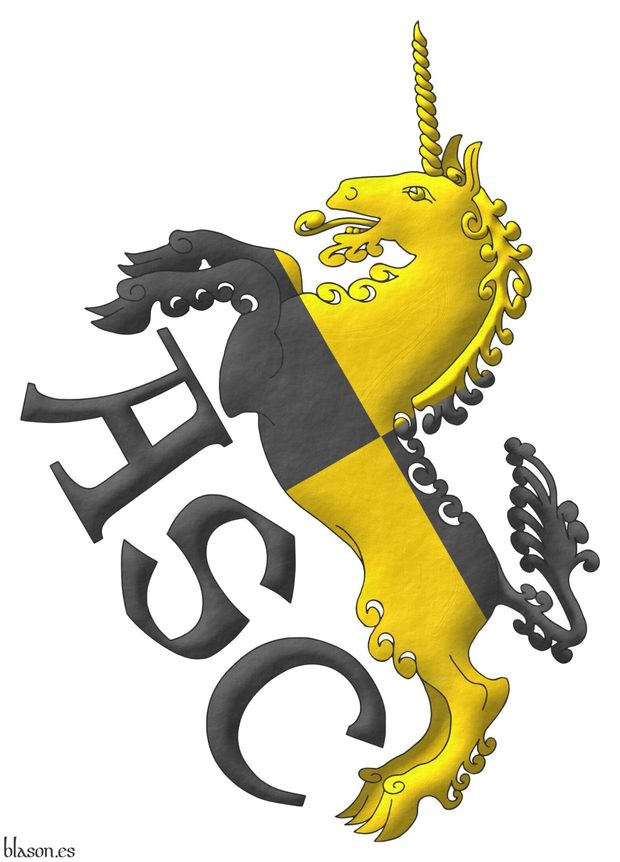
Neither own nor third party cookies
The owner of Blason.es does not register any personal data from the users through the well-known «cookies», neither own nor third party, neither session cookies nor technical cookies.
The domains listed in associated heraldry domains do not use «cookies» either.
In a future, only for statistic purposes
This site has no «cookies», but if any day «cookies» were instaled in Blason.es, the legally relevant notice would be issued. In any case, this would only be to record basic data of navigation, such as the device class (computer, mobile, tablet, etc.), the type of device browser and its version or the type of operating system the user has, without user identification and only to statistical effects and in order to improve the location of the contents and the quality of this site Blason.es and its associated heraldry domains.


![Ver [Zamora Vicente, A.; 1999] en referencias bibliográficas. Libro abierto, hojas de plata, filo de oro, guardas de gules, tapas de sable.](../css/Libro.Bibliografia.png)
Zamora Vicente, A.; 1999
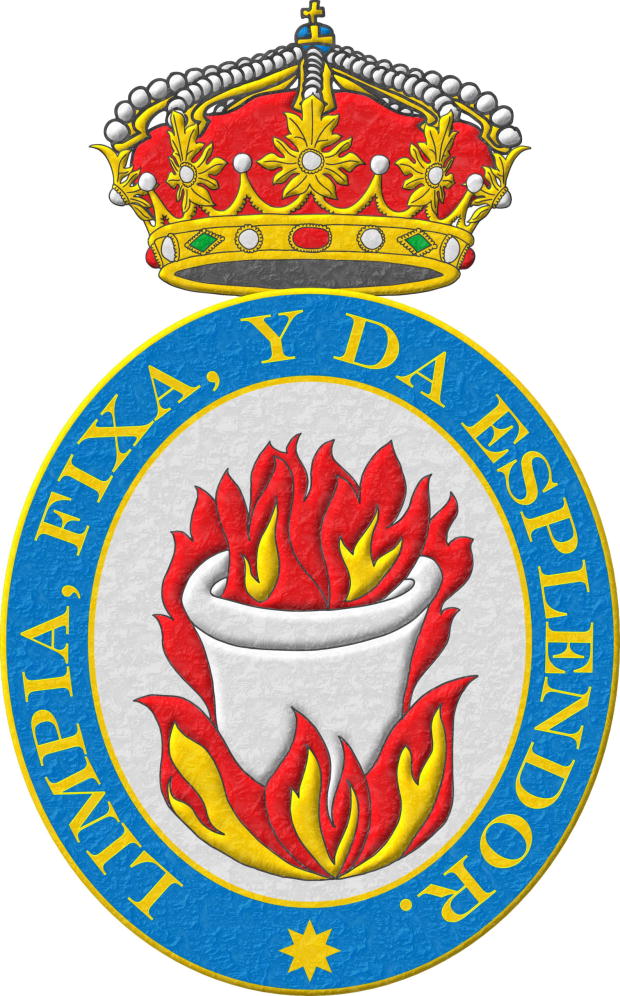
Alonso Zamora Vicente, «Historia de la Real Academia Española», Real Academia Española, Espasa Calpe, Madrid, 1999.
This bibliographic reference is illustrated with one of my interpretations of the emblem of the Real Academia Española. It is an oval emblem in Argent, with its crucible, also in Argent, over a bonfire of Gules and Or and surrounded by its flames, surmounted by a closed Royal crown with 8 arches, 5 of which are visible, and its motto, as originally written «Limpia, fixa, y da esplendor», around it.
Bibliographical reference of century XX.
Classification: Castilian language.
The author is Zamora Vicente, Alonso.
The following article cites this bibliographic reference:
External resource:


Lucius III

171st Pope of the Church, from the year 1181 to the year 1185. «Lucius III», born Ubaldo Allucinoli, was born in Lucca in northwest Italy.
Lozengy Argent and Azure.
Escudo losanjado de plata y azur.
Papal coat of arms interpreted by me with: a semicircular shield shape; a plain Argent field; checky or squares illuminated in Azure and outlined in Sable; and the whole design with a watercolor finish.
Blazon keywords: Without divisions, Lozengy, Argent and Azure.
Style keywords: Semi-circular, Illuminated, Outlined in sable and Hard metal.
Classification: Interpreted, Religious and Papal States.
Bearer: Lucius III.


Innocent IV
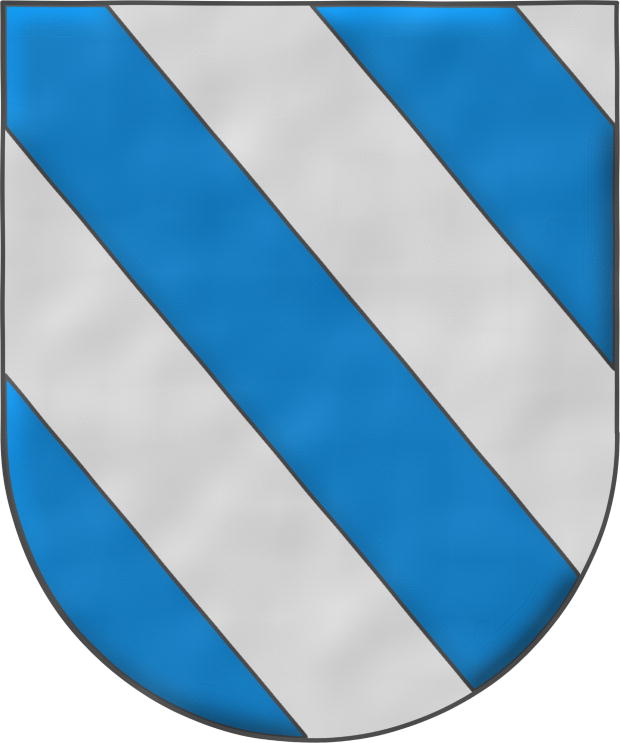
180th Pope of the Church, from 1243 to 1254. «Innocentius IV», born Sinibaldo dei Fieschi, was born in Manarola in northwest Italy.
Bendy of six Azure and Argent.
Escudo bandado de seis piezas de azur y plata.
Papal coat of arms interpreted by me with: a semicircular shield shape; a plain Argent field; bands illuminated in Azure and outlined in Sable; and the whole design with a watercolor finish.
Order of tinctures
In the bendy pattern, the tinctures are named starting from the one located at the dexter base of the shield and following an ascending sequence towards the sinister chief, although the most orthodox approach is to have only 2 tinctures, being one color and one metal.
Number of bands
It is said that it is not necessary to specify the number of bands when there are precisely 6, as in this case, and that it should be specified when there are, for example, 4 or 8. I have chosen to specify it for greater clarity of the blazon.
About the bendy pattern and the need to specify or not specify the number of its pieces, [Avilés, J.; 1725a; pages 40 and 41] and [Avilés, J.; 1780a; pages 45 and 46] say that it is «composed of four, six, or eight bends; in such a way that there are as many colors as metals, always specifying the number four and eight bands when blazoning, and not the one composed of six, as it is understood thus, without declaring the number of pieces» and without agreeing with it, and by its wording I believe that he is not entirely in agreement either, he adds «the reason that may exist for not specifying the number of six bends (although the authors do not express it) is that as the bend is one-third of the shield; and having six pieces, or six bends, the resulting number is doubled, as if the three parts were divided, which implies that the shield is filled with three bends; and taking the denomination of the figure infers, that the bendy is of six pieces: which does not happen with this equality in those of four and eight, requiring other proportions and consequently it becomes necessary to specify their number», therefore, note that the bendy of 6 does not follow the proportions of the bend, nor do those of 4 or 8, the only differential property of the one of 6 is being a multiple of 3, being 1/3 the width of the bend.
Blazon keywords: Without divisions, Bendy, Six, Azure and Argent.
Style keywords: Semi-circular, Illuminated, Outlined in sable and Watercolor.
Classification: Interpreted, Religious and Papal States.
Bearer: Innocent IV.


Urban IV
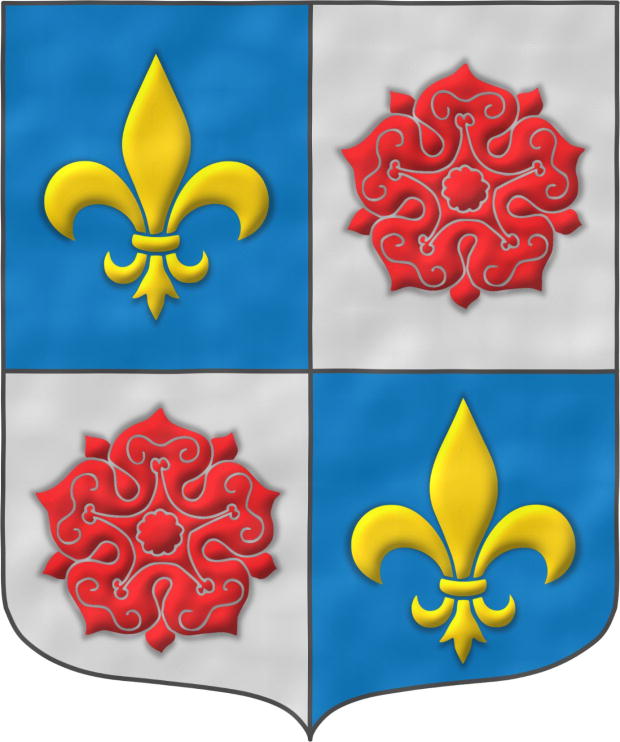
182nd Pope of the Church, from 1261 to 1264. «Urbanus IV», born Jacques Pantaleon of Court-Palais, was born in Troyes, France.
Quarterly: 1 and 4 Azure, a fleur de lis Or; 2 and 3 Argent, a rose Gules.
Escudo cuartelado: 1o y 4o de azur, una flor de lis de oro; 2o y 3o de plata, una rosa de gules.
Coat of arms of Urban IV with: a pointed and rounded shield shape; the field in plain Azure and Argent enamels; the figures outlined in the field, shaded and illuminated in Or and Gules; and with a watercolor finish.
Blazon keywords: Quarterly, Azure, One, Fleur de lis, Or, Argent, Rose and Gules.
Style keywords: Ogee, Illuminated, Shaded, Outlined in the field tincture and Watercolor.
Classification: Interpreted, Religious and Papal States.
Bearer: Urban IV.


Gregory X
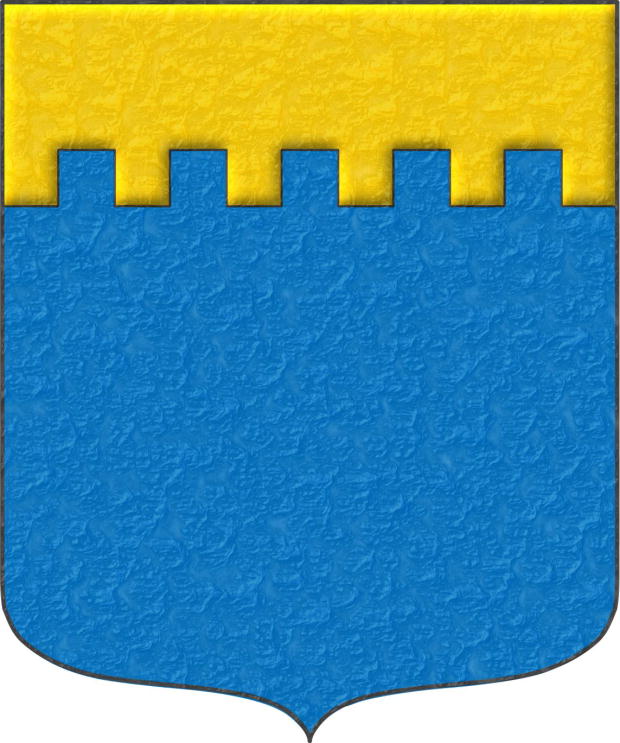
184th Pope of the Church, from 1271 to 1276. «Gregorius X», born Teobaldo Visconti, was born in Piacenza and convened the 14th Ecumenical Council, known as the Second Council of Lyon.
Azure, a chief embattled Or.
Escudo de azur, el jefe almenado de oro.
Papal coat of arms interpreted by me with: a pointed and rounded shield shape; the field in plain Azure; the chief embattled, illuminated in metal Or and outlined in Sable; and the whole with a marbled finish.
My first version of the blazon in English was «Azure, a chief Or, embattled», but Michael McCartney suggested that it was more correct as «Azure, a chief embattled Or».
Blazon keywords: Without divisions, Azure, Chief, Or and Embattled.
Style keywords: Ogee, Illuminated, Outlined in sable and Marmoreal.
Classification: Interpreted, Religious and Papal States.
Bearer: Gregory X.


Adrian V
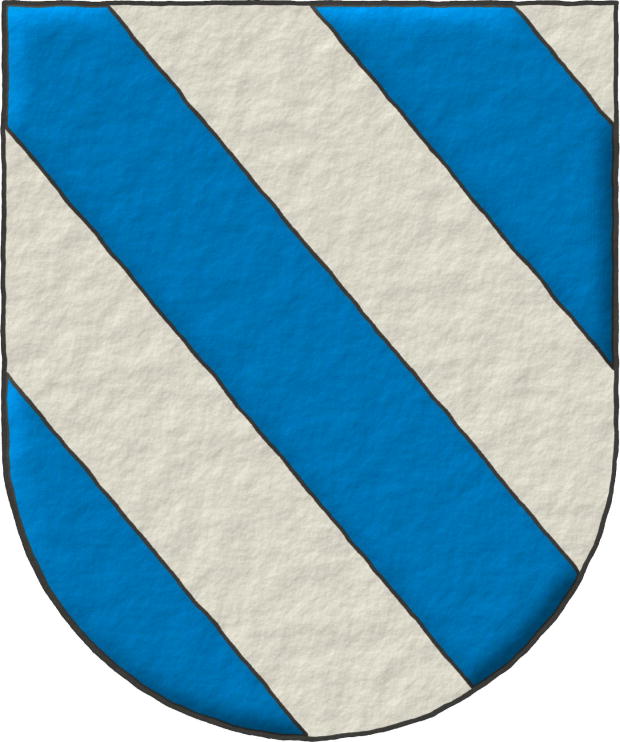
186th Pope of the Church, only 40 days in 1276. «Hadrianus V», born Ottobuono de Fieschi, was born in Genoa.
Bendy of six Azure and Argent.
Escudo bandado de seis piezas de azur y plata.
Papal coat of arms interpreted by me with: a shield with a rounded arch top; the field in plain tincture of Argent; the bands illuminated in Azure and outlined in Sable; and the whole in an elevated line style.
The blazon in French is «Bandé d'azur et d'argent de six pièces».
The banding is defined in [Avilés, J.; 1725a; page 40] and [Avilés, J.; 1780a; page 45] as the shields and also, the chiefs, fesses, pales, and figures, such as animals, etc., that are «covered and filled with bands in equal number, with as many of metal as of color».
Blazon keywords: Without divisions, Bendy, Six, Azure and Argent.
Style keywords: Semi-circular, Illuminated, Outlined in sable and Freehand.
Classification: Interpreted, Religious and Papal States.
Bearer: Adrian V.

Continue with: John XXI.
-
Language
-
Categories of heraldry
-
Divisions of the field
- Without divisions
- Party per pale
- Party per fess
- Party per bend
- Party per bend sinister
- Tierce
- Tierce sinister
- Tierced per pale
- Tierced per fess
- Tierced per bend
- Tierced pallwise inverted
- Quarterly
- Quarterly per saltire
- Gyronny
- Party per fess, the chief per pale
- Party per pale, the sinister per fess
- Party per fess, the base per pale
- Party per pale, the dexter per fess
- Chapé
- Chaussé
- Embrassé
- Contre-embrassé
- Party per chevron
- Enté
- Enté en point
- Flanched
-
Metals
-
Colours
-
Furs
-
Other tinctures
-
Ordinaries and sub-ordinaries
-
Diminutives of the ordinaries
-
Geometric charges
-
Composite ordinaries
-
Inanimate charges from Nature
Atom, Crescent, Diamond, Emerald, Estoile, Increscent, Lightning flash, Moon, Mount, Mullet, Mullet of four points, Orbital, Plough of Ursa Major, Rainbow, Ray of the sun, River, Sea, Snowflake, Sun, Sun in splendour, Sun of May, Trimount, Water and Wave.
-
Vegetal charges from Nature
Acorn, Apple, Apple tree, Ash, Bluebonnet, Camellia, Chrysanthemum, Cinquefoil, Cornflower, Dogwood flower, Double rose, Elm, Fleur de lis, Flower, Gourd, Holm oak, Hop cone, Kapok tree, Laurel, Lily, Linden, Lotus flower, Madonna lily, Mexican cedar tree, Oak, Olive tree, Palm tree, Plantain plant, Pomegranate, Poplar leaf, Rose, Shamrock, Sunflower, Thistle, Tree, Tulip, Vine and Wheat.
-
Animal charges from Nature
Badger, Bald eagle, Barbel, Barn owl, Bear, Beaver, Beetle, Bighorn sheep, Blackbird, Boar, Brach hound, Bull, Doe, Dog, Dolphin, Dove, Eagle, Elephant, Falcon, Female figure, Fish, Flame, Fly, Fox, Frog, Goat, Goldfinch, Goose, Heron, Horse, Hummingbird, Jaguar, Lark, Leopard, Lion, Lion passant, Lion rampant guardant, Lioness, Lynx, Male figure, Martlet, Merino ram, Owl, Panther, Parrot, Peacock, Pelican, Pelican in her piety, Puffin, Quetzal, Raven, Roe deer, Rooster, Savage, Seagull, Serpent, She-wolf, Stag, Starling, Talbot, Tyger, Vulture, Warren hound and Wolf.
-
Parts of natural charges
Arm, Beak, Branch, Caboshed, Chest, Claw, Covert, Dorsal fin, Eagle claw, Ermine spot, Escallop, Feather, Foot (palmiped), Foreleg, Forepaw, Hand, Head, Heart, Hoof, Leaf, Neck, Ostrich feather, Palm frond, Paw, Roe deers' attires, Shoulder, Sprig, Stags' attires, Stem, Swallow-tail, Tail, Tail addorsed, Tail fin, Talon, Tibia, Tooth, Trunk, Trunk (elephant), Two hands clasped, Two wings in vol, Udder, Wheat spike, Wing and Wrist.
-
Artificial charges
Ace of spades, Anchor, Anvil, Arch, Arm vambraced, Armillary sphere, Arrow, Axe, Bell, Bell tower, Beret, Bonfire, Book, Bookmark, Bow, Branding iron, Bridge, Broken, Buckle, Cannon, Cannon dismounted, Cannon port, Canopy roof, Carbuncle, Castle, Celtic Trinity knot, Chain, Chess rooks, Church, Clarion, Clay pot, Closed book, Club, Column, Comb, Compass rose, Conductor's baton, Cord, Covered cup, Crozier, Crucible, Cuffed, Cup, Cyclamor, Dagger, Double vajra, Drum, Ecclesiastical cap, Fanon, Federschwert, Fleam, Four crescents joined millsailwise, Galician granary, Garb, Gauntlet, Geometric solid, Grenade, Halberd, Hammer, Harp, Host, Hourglass, Key, Key ward, Knight, Knot, Lantern, Letter, Line, Loincloth, Menorah, Millrind, Millstone, Millwheel, Monstrance, Mortar, Mullet of six points pierced, Nail, Non-classic artifact, Norman ship, Number, Oar, Oil lamp, Open book, Page, Pair of scales, Parchment, Pestle, Piano, Pilgrim's staff, Plough share, Polish winged hussar, Port, Portcullis, Potent, Quill, Ribbon, Rosette of acanthus leaves, Sabre, Sackbut, Sail, Scroll, Scythe, Sheaf of tobacco, Ship, Skirt, Spear, Spear's head, Stairway, Star of David, Step, Sword, Symbol, Tetrahedron, Torch, Tower, Trident, Trumpet, Turret, Two-handed sword, Wagon-wheel, Water-bouget, Wheel, Winnowing fan and With a turret.
-
Immaterial charges
Angel, Archangel, Basilisk, Dragon, Dragon's head, Garuda, Golden fleece, Griffin, Heart enflamed, Justice, Mermaid, Our Lady of Mercy, Ouroboros, Paschal lamb, Pegasus, Phoenix, Sacred Heart of Jesus, Saint George, Sea-griffin, Trinity, Triton, Unicorn, Winged hand and Wyvern.
-
External elements
-
Heraldic creations
-
References
-
Formats
-
Keywords on this page
Watercolor, Addorsed, Adrian V, Embattled, Azure, Bendy, Bibliography, Overall, Ogee, Crown, Closed royal crown, Crescent, Crucible, Quarterly, Outlined in sable, Outlined in the field tincture, Within, Two, Emblem, At the nombril, Escutcheon, Coat of arms, Papal States, Scroll, Fleur de lis, Hafted, Gregory X, Gules, Axe, Bonfire, Illuminated, Innocent IV, Interpreted, Chief, John XXI, Legal notice, Motto, Castilian language, Enflamed, Lozengy, Semi-circular, Or, Argent, Without divisions, Religious, Six, Shaded, Freehand and One.
